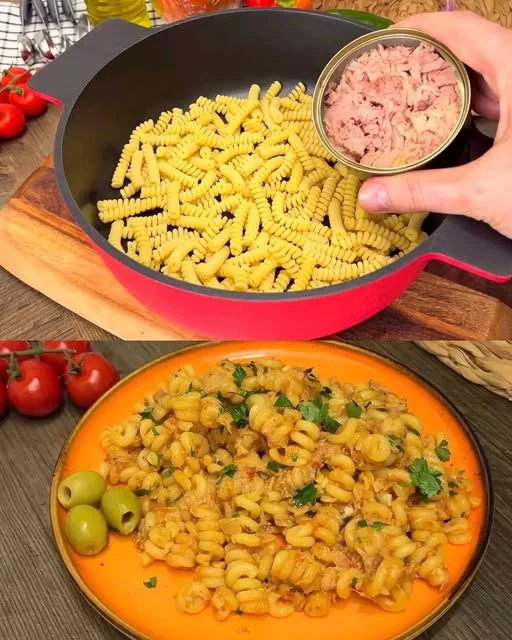Advertisement
When I think about food that has stood the test of time, I’m immediately brought back to a dish that has always been a constant in my life—the simple yet satisfying combination of tuna and pasta. As a child, my mother would often make this meal when we needed something quick, comforting, and easy to prepare. It wasn’t just about the taste; it was about the experience of sitting down with my family, laughing, and sharing a meal that felt like home.
There’s something deeply emotional about food that ties us to moments, to memories, and to the people we love. This dish was a staple in our kitchen—a reminder of those evenings when we would gather together after a long day, the smell of garlic and onions filling the air. It wasn’t fancy or extravagant, but it was always satisfying, nourishing, and full of heart. Tuna and pasta became one of those meals that connected generations, passed down through family stories and shared laughter.
To this day, every time I make this dish, I’m transported back to those moments. It’s a meal that, though simple, has the ability to evoke nostalgia and warmth. The flavors come together effortlessly, each bite comforting and familiar. This tuna pasta recipe isn’t just food; it’s a connection to my past and the traditions that shaped my love for cooking.
The Allure of Simplicity: Why Tuna Pasta Is Timeless
Tuna and pasta may sound simple, but there’s a beauty in its simplicity. At the core of this dish are a few basic ingredients that, when combined, create something deeply satisfying. The beauty lies in the balance of flavors and textures. The tuna adds a savory, rich taste, while the pasta provides a satisfying base. The onions and garlic bring depth, while the fresh basil and thyme offer an aromatic, herbal lift.
One of the reasons this dish has endured over time is its versatility. It can be easily customized to suit your taste or what’s available in your pantry. Want a little heat? Add chili peppers. Craving a burst of acidity? Toss in some capers or a squeeze of lemon. This dish doesn’t need to be overly complicated to shine—it’s a perfect example of how simple ingredients can come together in a way that feels both familiar and exciting.
The combination of canned tuna and pasta also makes it a practical choice for any busy weeknight or when you’re looking to clear out your pantry. The ingredients are pantry staples, so you don’t need to make a special trip to the grocery store. And yet, despite its humble roots, the dish can feel luxurious and satisfying, especially with a sprinkle of fresh cheese and parsley to finish.
Ingredients
| Ingredients | |
|---|---|
| 1 can of tuna | |
| Olive oil (for sautéing) | |
| 1 onion, chopped | |
| 2 cloves of garlic, minced | |
| Chili pepper (optional) | |
| Fresh basil and thyme | To taste |
| 250g pasta | Any type of your preference |
| 500 ml water | |
| 1 tomato, diced | |
| 50g cheese (grated) | Preferably Parmesan or mozzarella |
| Fresh parsley | For garnish |
| 1 tbsp tomato paste | |
| Capers (optional) | For added briny flavor |
Directions
- Sauté the Aromatics: Heat a tablespoon of olive oil in a large pan over medium heat. Add the chopped onion and cook for about 5 minutes, or until softened. Add the minced garlic and chili pepper (if using) and cook for another minute, allowing the flavors to bloom.
- Incorporate Tomato Paste: Stir in the tomato paste, cooking for 2-3 minutes until it darkens slightly and releases its flavors.
- Cook the Pasta: Bring 500 ml of water to a boil in a separate pot. Add the pasta and cook according to the package instructions until al dente. Drain the pasta, reserving a bit of the pasta water.
- Combine Tuna and Veggies: Add the canned tuna to the pan with the sautéed onion and garlic mixture. Break up the tuna with a spoon. Stir in the diced tomato and cook for a few more minutes until the tomato softens. Add fresh basil and thyme, then season with salt and pepper to taste.
- Combine Pasta with Sauce: Add the cooked pasta to the tuna and tomato sauce. If the sauce is too thick, add a little of the reserved pasta water to achieve your desired consistency. Stir well to coat the pasta with the sauce.
- Finish with Cheese and Garnish: Sprinkle the grated cheese over the pasta and toss it into the sauce to melt the cheese. Garnish with fresh parsley and, if desired, capers for an extra burst of flavor.
Nutrients
| Nutrient | Amount per Serving |
|---|---|
| Calories | 400 kcal |
| Protein | 25 g |
| Carbohydrates | 45 g |
| Fat | 14 g |
| Fiber | 3 g |
| Sugars | 4 g |
The Versatility of Tuna and Pasta: Customizing to Taste
One of the most wonderful aspects of this recipe is its adaptability. While the core ingredients—tuna, pasta, and a few aromatics—remain constant, there are countless ways to personalize this dish based on what you have on hand or what you’re craving. Here are a few ideas for customizing your tuna pasta:
- Adding Vegetables
If you love incorporating more vegetables into your meals, this dish is perfect for experimenting. Consider adding spinach, zucchini, or even mushrooms for added texture and flavor. If you have frozen peas or sweet corn on hand, those work wonderfully as well. - Choosing Different Pasta
The type of pasta you choose can change the entire dish. While traditional spaghetti is a great option, you could also try penne, fusilli, or farfalle for a fun twist. The shape of the pasta can alter the way the sauce clings, giving each bite a slightly different texture. - Spice It Up
For those who enjoy a little heat, adding chili pepper (as suggested in the recipe) can really elevate the dish. You can also experiment with red pepper flakes, a dash of hot sauce, or even a sprinkle of smoked paprika for a smoky kick. - Herb Variations
The fresh basil and thyme in this dish provide a fragrant herbaceous note, but don’t be afraid to experiment with other herbs. Try oregano for an Italian twist, or add rosemary for a deeper, earthy flavor. Fresh parsley is an excellent garnish, adding a pop of color and brightness. - Cheese Choices
While mozzarella or Parmesan is often the go-to for this recipe, feel free to experiment with other cheeses. A sharp cheddar could add a unique richness, while goat cheese could provide a creamy tang. For an extra indulgent option, a sprinkle of ricotta or a dollop of cream could turn this dish into a creamy, comforting meal.
The Nutritional Benefits of Tuna and Pasta
Though tuna pasta is known for its comfort, it’s also surprisingly nutritious. Packed with protein from the tuna and a good dose of fiber from the pasta (especially if you opt for whole wheat or gluten-free pasta), this dish can keep you feeling full and satisfied without the heaviness that some other comfort foods bring.
Protein
Tuna is an excellent source of lean protein. It’s rich in essential amino acids that help build and repair muscle, making this dish a great post-workout meal. Protein also helps keep you feeling fuller for longer, reducing the chances of overeating or snacking between meals.
Healthy Fats
Though not as high in fat as some other dishes, the olive oil used to sauté the onions and garlic is a heart-healthy fat. Olive oil is a staple of the Mediterranean diet, known for its anti-inflammatory properties and benefits to cardiovascular health.
Carbohydrates
The pasta in this dish provides a source of complex carbohydrates. These carbs are an important part of a balanced diet, providing energy and helping stabilize blood sugar levels. Whole wheat pasta is a great option if you’re looking for additional fiber.
Vitamins and Minerals
The addition of herbs like basil and thyme offers a range of vitamins and minerals, including Vitamin C, Vitamin A, and various antioxidants. These help support your immune system and overall health.
Frequently Asked Questions
Can I use a different type of pasta?
Yes! While traditional pasta works best, you can experiment with various types like whole wheat, gluten-free, or even spiralized zucchini for a low-carb option.
What if I don’t have fresh herbs?
If you don’t have fresh basil or thyme, you can use dried herbs instead. Just be sure to adjust the quantities, as dried herbs are more concentrated in flavor than fresh ones.
Can I make this dish vegetarian?
Yes, you can easily adapt this recipe to be vegetarian by replacing the tuna with sautéed mushrooms or a plant-based protein of your choice.
Can I make this dish ahead of time?
Tuna pasta is best enjoyed fresh, but you can make it ahead of time and store it in the refrigerator for up to 2 days. Reheat it on the stove with a splash of water to keep the sauce from drying out.
Advertisement
What can I serve with tuna pasta?
This dish pairs well with a side salad, garlic bread, or even some roasted vegetables. A light white wine, such as Pinot Grigio, can complement the meal perfectly.
Conclusion: A Meal that Speaks to the Heart
Tuna and pasta may seem like a simple combination, but it’s a meal that carries with it a sense of home and comfort. Its humble origins remind us that sometimes the best meals are the simplest ones, and it’s the little moments we share over these meals that become the most cherished memories. Whether you’re cooking for yourself or sharing it with friends and family, this dish brings people together, one bite at a time.
As I continue to make this dish in my own kitchen, I think about the countless times I’ve shared it with loved ones. It’s more than just a recipe—it’s a piece of my history, my connection to the past, and a tradition I hope to pass on. In a world full of complex recipes and extravagant meals, sometimes it’s the most straightforward dishes, like tuna and pasta, that remind us of the joy found in simplicity. So, whether you’re looking for a quick weeknight meal or a comforting dish that brings back memories, this tuna pasta recipe will always be there to deliver warmth, flavor, and a sense of belonging.


